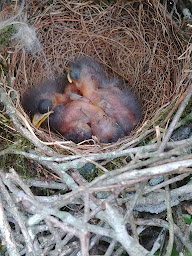We spend a lot of time filling bird feeders and trying to find the right combination to bring in the most beautiful and the rarest species. When the reality is, our natural surroundings will bring in a lot more than any feeder ever will. Understanding the plants that surround us naturally is the first step toward making a home for wildlife.
 |
| Robin Hatchlings |
A lot of times we pull up the perennial plants or cut them back to the ground as soon as they start to lose their foliage and look as though they are waiting at death's door. However, if we can discipline ourselves to look past the unsightly twigs and remnants of beauty that once was, we can begin to see the beauty that is attracted to the unattractive. Birds! Leaving our perennial gardens intact through the winter gives our winter avian residents a food source. When we cut down what's left at the end of the growing season we are denying the birds a fulfilling meal and we deny ourselves the pleasure of watching them engage their survival instincts and do the things they were created to do in the way that is natural to them.
Coneflower and black-eyed Susans have very sturdy stalks and can withstand some snow and ice. Just imagine for a moment that you are a bird. Overnight your world has been blanketed by snow and ice.
 |
| Black-eyed Susan |
Finding food can be a challenge. But if we leave our perennial stalks standing, they provide a food source that stands above the wintery weather and can make the snowy winter days a lot easier on the little birds.
Maybe you could plan to make a garden in the back yard for the sole purpose of feeding the birds and wildlife through the winter. Choose flowers and shrubs that offer berries and seeds throughout the winter.
Asters, Black-eyed Susans, and coneflower all offer nutrition for the birds that overwinter in our area.
Joe pie weed offers a source of food but also adds the luxury of warmth. Birds will use the "fluff" that comes with the seeding process to line their nests in the winter.
Gaultheria not only is a beautiful little plant but it is also evergreen and produces beautiful red berries that feed birds and squirrels.
A buttonbush is a great option if you are looking to attract butterflies and birds. While in bloom the butterflies and other various nectar loving creatures will visit often. When the blooms begin to seed, birds will gather for the feast.
Beautyberry is a native and attracts insects while in bloom. These insects help to provide a source of food for the seasonal birds and its berries help provide food for the ones that are year-round residents.
If you are looking for a centerpiece for your fauna food bed why not consider a styrax tree. they are 6 to 12 feet tall at maturity so that makes them perfect for a focal point. They have small white bell-shaped flowers that attract many different kinds of nectar loving pollinators. This, in turn, will attract the birds of summer. Then the blooms give way to many seeds that birds enjoy through the fall and winter.
There are others that you can plant for you and the birds to enjoy such as blueberry, blackberry, mulberry, and raspberry. Just plan to plant more than one so you will have enough to share with our feathered friends.
The possibilities are endless. Most perennials offer something in every season. the key to success is to be patient and let nature do what it was created to do. Think about it, you plant to repel bugs, you plant to attract hummingbirds and butterflies why not plant to feed the birds of winter? Did you ever stop to think about how they survive the winter? It isn't easy I'm sure but we can share our blessings and make it a little easier. All those seeds that you pour into a feeder had to come from plants somewhere. Why not grow those plants and provide your feathered friends with some natural order. Birds are used to fending for themselves and by providing feeders we deny them the experience they need to survive. So many of the seed mixes that are available commercially are not native blends. It can be confusing to the birds as they are not accustomed to some of the varieties within those mixes. We think we are doing them a favor when in reality we may be making survival harder than it has to be.
Think natural. Think native!
For more information on when to feed, how to feed, and why or why not to feed, Visit the Audobon website.

No comments:
Post a Comment